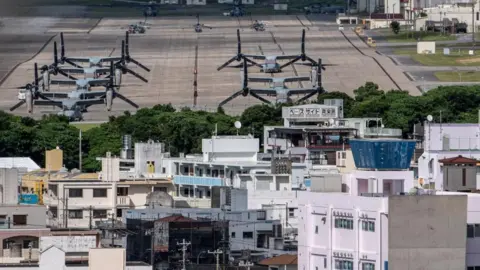[ad_1]
By Joel Guinto, BBC News
 Getty Images
Getty ImagesA US soldier has been charged with the kidnapping and rape of a teenage girl in Okinawa, a Japanese island chain that hosts the region’s largest American military base.
The case is likely to stoke the long-standing local opposition to US military presence – the islands are home to more than half of the 54,000 US soldiers serving in Japan.
The anger has also been fuelled by sexual assault cases – one of the most high-profile was in 1995, when a 12-year-old girl was raped by three US service personnel, sparking months-long protests.
The latest allegation also involves a minor, who is younger than 16, the age of consent in Japan.
The 25-year-old Air Force man allegedly assaulted her on 24 December and he was identified through security camera footage after the girls’ family reported it, local media said.
He was charged in late March and has been in the custody of Japanese authorities since then, government spokesman Yoshimasa Hayashi said on Tuesday when he revealed the charges to the public.
“We will continue to request the US side to prevent such incidents at every opportunity,” Mr Hayashi said, adding that US officials were cooperating fully with investigators.
He also said Japan’s Ministry of Foreign Affairs has lodged a complaint with the US Ambassador to Japan, Rahm Emmanuel. He added that the first hearing in the case is scheduled for 12 July.
The case is “not just disturbing… but also a violation of the girl’s dignity”, and “brought a significant level of distrust”, Okinawa governor Denny Tamaki said.
Local media reported that the soldier was off duty when he allegedly approached the girl at a park and asked her to get into his car so they could talk. He then drove her to his home where he allegdly raped her.
Japan hosts one of the world’s largest American military forces outside the US.
About 30,000 American soldiers are stationed across Okinawa, where the US has kept military bases since defeating Japan in World War Two.
The bases have become increasingly strategic for Washington because Okinawa’s proximity to Taiwan allows the US to respond quickly to any Chinese threat.
 Getty Images
Getty ImagesThe heavy American presence is reflected in the malls, shops and restaurants that serve steak, burgers, tacos and root beer floats across the island chain.
In cities like Ginowan, home to a major US base called Futenma, it is not uncommon for locals to wake up up to the whirring sound of Osprey engines or see them flying over public housing.
Seven in ten Okinawans feel that the concentration of US bases on their islands is “unfair”, according to an opinion poll last year.
While protests against the bases are common, young people in Japan are growing more resigned to US military presence, the same poll showed.
Still, accidents and crimes where the victims are Japanese have long stirred tension around the American presence.
In 2012, a US Navy officer killed two Japanese citizens in a car accident during a trip to Mount Fuji.
After 1995, the next big protests happened in 2017 when a US army base worker was convicted for the rape and murder of a 20-year-old local woman.
In 2013, two US Navy sailors were jailed for the rape of an Okinawan woman in her 20s. The case led to curfews for US troops all over Japan.
There have been efforts to move the US bases to less populated parts of Okinawa, but locals want them removed altogether.
Experts, however, say Japan’s miliatry alliance with the US is too strong for that to happen. And they say Tokyo needs Washington given the challenges it faces, be it China’s growing claims over disputed waters and islands, or North Korea’s barrage of missile tests.
[ad_2]
Source link freeslots dinogame telegram营销




